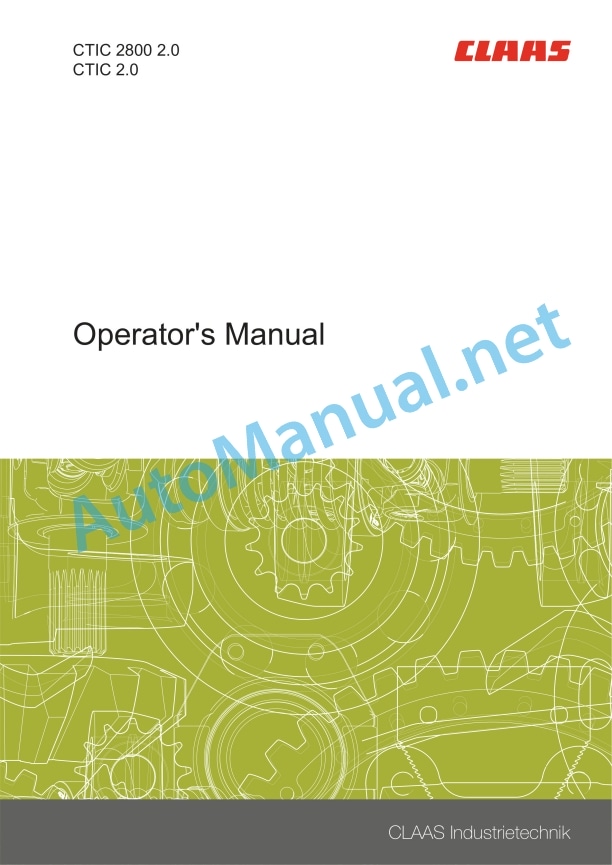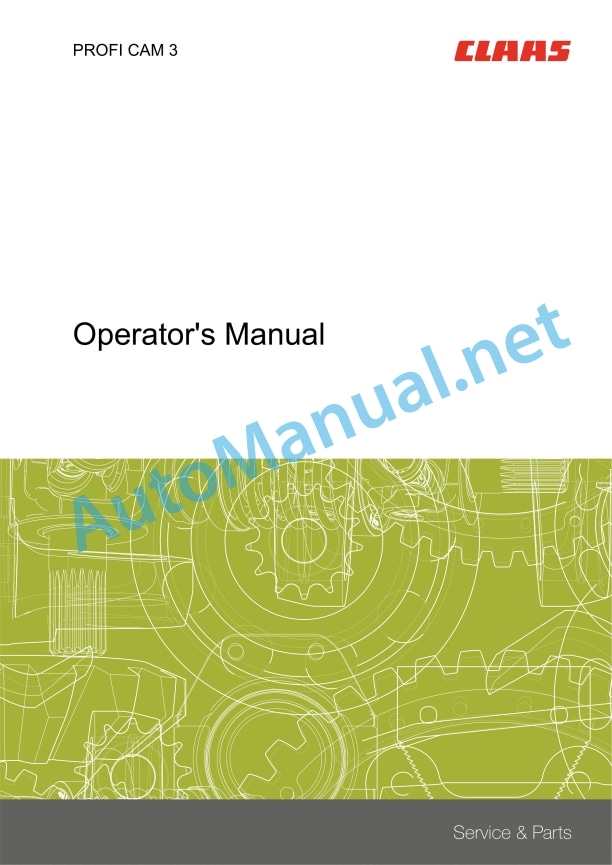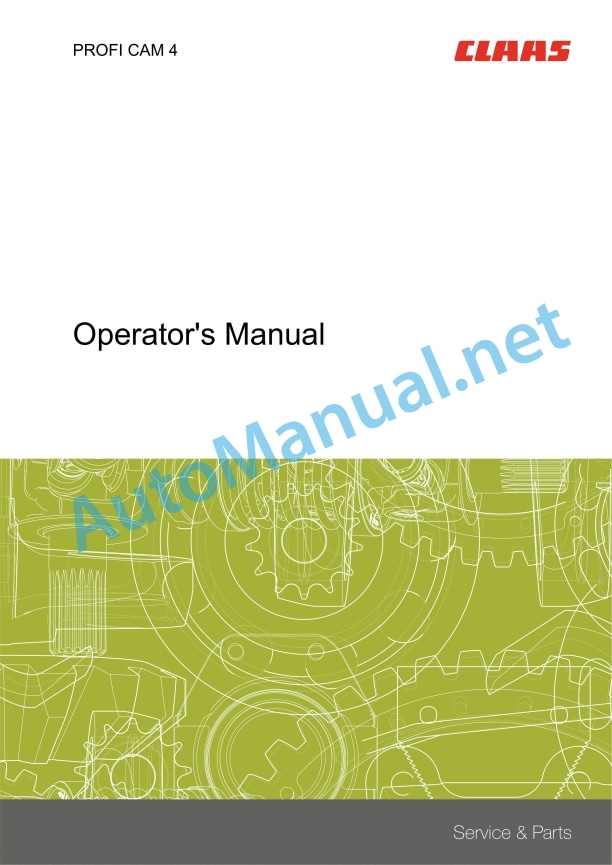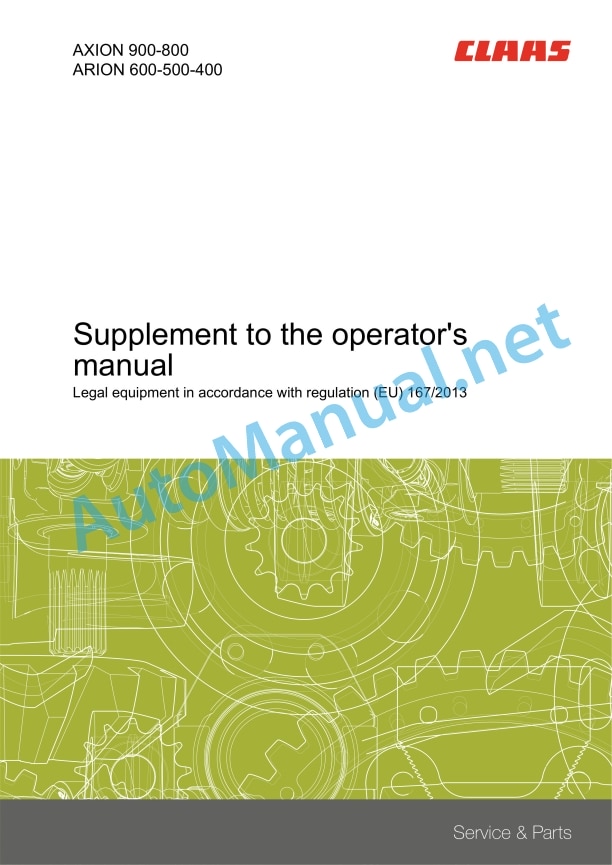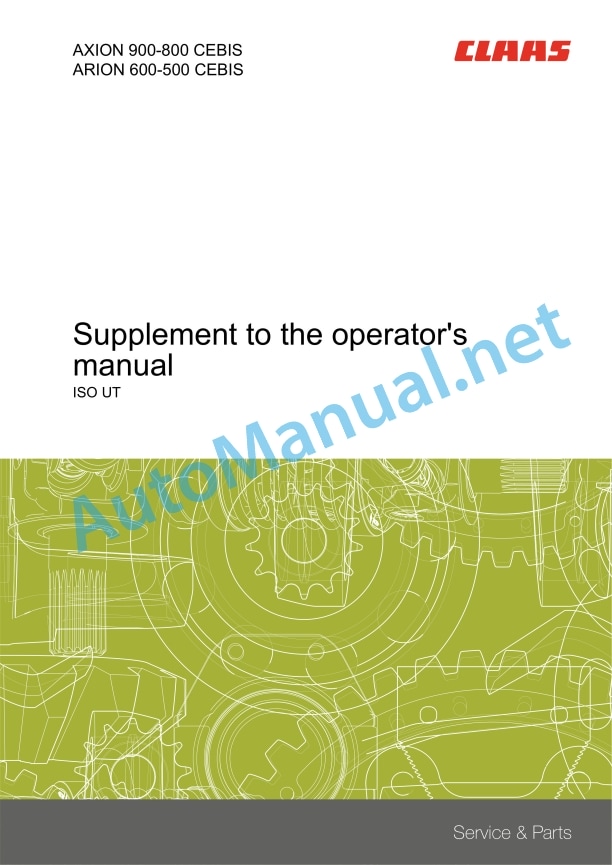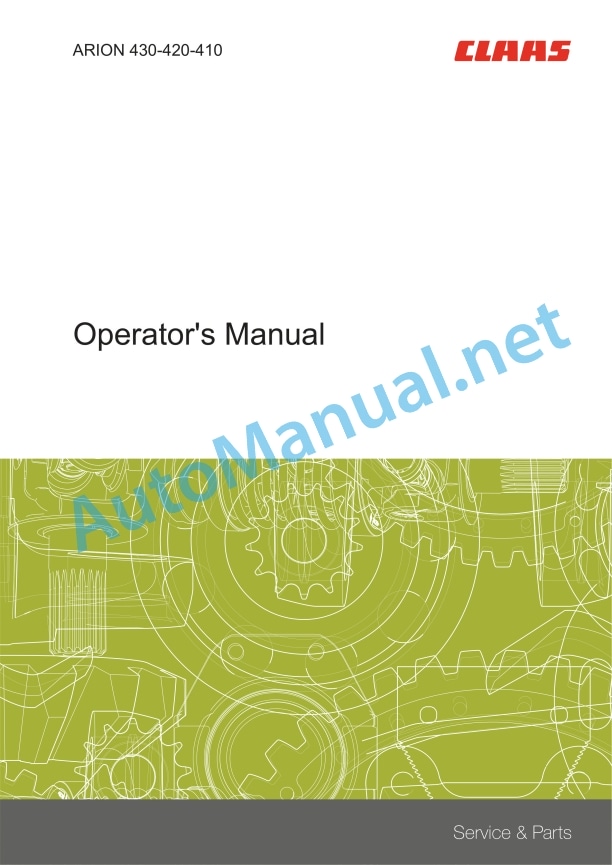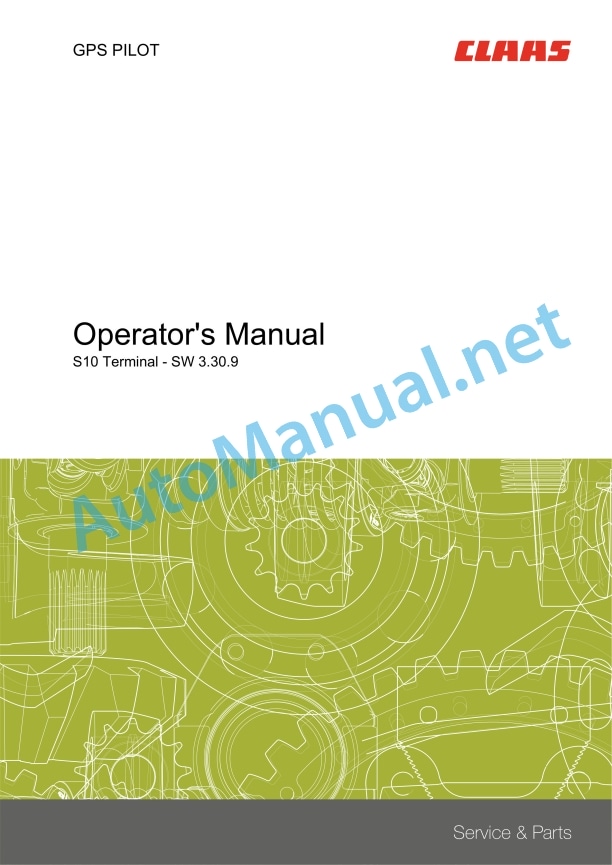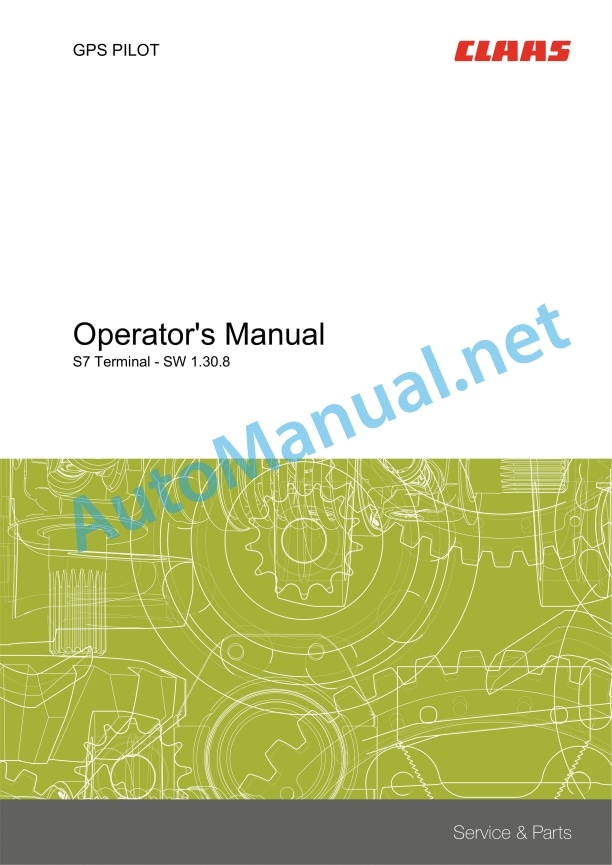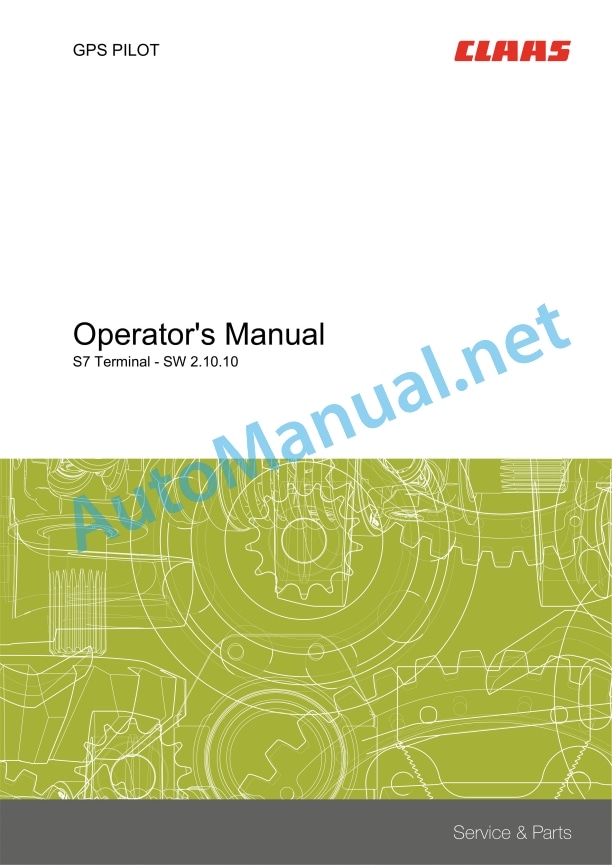Claas Arion 430-410 (A21) Tractors Operator Manual EN
$50.00
- Model: Arion 430-410 (A21) Tractors
- Type Of Manual: Operator Manual
- Language: EN
- Format: PDF(s)
- Size: 371 MB
File List:
00 0018 552 1.pdf
00 0289 108 1.pdf
00 0301 051 0.pdf
00 0303 482 0.pdf
00 1140 877 0.pdf
00 1169 984 0.pdf
00 1170 296 2.pdf
00 1171 315 0.pdf
00 1171 709 0.pdf
00 1405 164 7.pdf
00 1405 184 7.pdf
00 1420 028 4.pdf
00 1420 056 2.pdf
00 2182 128 0.pdf
00 2182 364 0.pdf
00 0018 552 1.pdf:
TELEMATICS Website
Table of contents
1 About this Concise Operator’s Manual
1.1 Notes on the manual
1.1.1 Validity of manual
1.1.2 Notes regarding the Concise Operator’s Manual
1.1.3 Notes on warranty
2 Safety
2.1 Intended use
2.1.1 Proper use
3 Product description
3.1 Overview and method of operation
3.1.1 TELEMATICS product variants
3.1.2 TONI (TELEMATICS on implements)
3.1.3 Fleet View
3.1.4 TELEMATICS basic
3.1.5 TELEMATICS advanced
3.1.6 TELEMATICS professional
3.1.7 TELEMATICS app
4 Operating and control elements
4.1 TELEMATICS overview
4.1.1 Illustration conventions of buttons and navigation elements
4.1.2 Symbols and colours
4.2 Menu structure
4.2.1 Start screen
4.2.2 TELEMATICS website site map
4.2.3 Main menu overview
4.2.4
4.2.5
4.2.6
00 0289 108 1.pdf:
CTIC 2800 2.0CTIC 2.0
Table of contents
1 Introduction
1.1 General information
1.1.1 Validity of manual
1.1.2 Information about this Operator’s Manual
1.1.3 Symbols and notes
1.1.4 Optional equipment
1.1.5 Maintenance information
1.1.6 Warranty information
1.1.7 Qualified specialist workshop
1.1.8 Spare parts and technical questions
1.2 Intended use
1.2.1 Intended use
1.2.2 Reasonably foreseeable misuse
2 Safety
2.1 Identifying warnings
2.1.1 Hazard signs
2.1.2 Signal word
2.2 Safety rules
2.2.1 Importance of Operator’s Manual
2.2.2 Optional equipment and spare parts
2.2.3 Danger due to damage to the tyre pressure control system
2.2.4 Technical condition
2.2.5 Complying with technical limit values
2.2.6 Keeping protective devices functional
2.2.7 Personal protective equipment
2.2.8 Dangers when driving on the road and on the field
2.2.9 Environmental protection and disposal
2.2.10 Noise can damage your health
2.2.11 Pressurised fluids
2.2.12 Compressed air
2.2.13 Hot surfaces
2.2.14 Maintenance work and repair work
2.2.15 Welding work prohibited
3 Product description
3.1 Package list
3.1.1 Delivery state
3.2 Overview and method of operation
3.2.1 Tyre pressure control system
3.2.2 Tyre pressure control system
3.3 Safety devices
3.3.1 Mechanical and electronic safety features
Pressure limitation
System behaviour when an air line is torn off
Manual operation
3.4 Identification plates and identification numbers
3.4.1 Identification plate of tyre pressure control system
4 Operating and display elements
4.1 Monitor
4.1.1 Overview of operating screen
4.2
4.2.1
4.2.2
4.3
4.3.1
4.3.2
4.3.3
4.3.4
4.4
4.4.1
5 Technical specifications
5.1 Tyre pressure control system
5.1.1 Properties
5.1.2 Lubricants
6 Handling
6.1 Transport and storage
6.1.1 Transport
Compressor
6.1.2 Storage
7 Preparing the product
7.1 Putting into operation
7.1.1 Carry out prior to operation
Installing the tyre pressure control system
Workplace description
8 Operation
8.1 Tyre pressure control system
8.1.1 Observe prior to operating the system
8.1.2 Parking position
Removing the rotary transmission leadthrough cover
Removing the rotary transmission leadthrough cover
Moving the hose packages of front wheels to the parking position
Moving the hose package of the rear right wheel to the parking position
Moving the hose package of the rear left wheel to the parking position
Installing the cover on the rotary transmission leadthrough
Installing the cover on the rotary transmission leadthrough
Removing the rotary transmission leadthroughs
8.1.3 Parking position
Removing the rotary transmission leadthrough cover
Removing the rotary transmission leadthrough cover
Moving the hose packages of front wheels to the parking position
Moving the hose package of the rear right wheel to the parking position
Moving the hose package of the rear left wheel to the parking position
Installing the cover on the rotary transmission leadthrough
Installing the cover on the rotary transmission leadthrough
Removing the rotary transmission leadthroughs
8.1.4 Working position
Installing the rotary couplings
Moving the hose packages of front wheels to the working position
Moving the hose package of the rear right wheel to the working position
Moving the hose package of the rear left wheel to the working position
Installing the cover on the rotary transmission leadthrough
Installing the cover on the rotary transmission leadthrough
8.1.5 Working position
Installing the rotary couplings
Moving the hose packages of front wheels to the working position
Moving the hose package of the rear right wheel to the working position
Moving the hose package of the rear left wheel to the working position
Installing the cover on the rotary transmission leadthrough
Installing the cover on the rotary transmission leadthrough
8.1.6 Determining the wheel loads
Fundamentals for determining wheel loads
Determining the wheel load on the front axle
Determining the wheel load on the rear axle
Determining the wheel load of the hitched implement
Example of how to calculate the wheel loads
8.1.7 Activating the tyre pressure control system
8.1.8 Deactivating the tyre pressure control system
8.1.9 Creating a profile
Entering the profile name
Setting the tyre pressure values for the towing vehicle
Enabling the trailer
Trailer priority circuit
Setting the tyre pressure values for the trailer
Selecting the tyre size
8.1.10 Changing the profile
8.1.11 Deleting the profile
8.1.12 Activating the profile
Operating the profile in
Changing set values in
Operating the profile in
9 Faults and remedies
9.1 Tyre pressure control system
9.1.1 Overview of possible problems with the tyre pressure control system
10 Maintenance
10.1 Maintenance interval overview
10.1.1 Operating hours
10.1.2 Every 10 operating hours or daily
10.1.3 Every 600 operating hours
10.1.4 Every 1200 operating hours or annually
10.1.5 Maintenance work every 2400 operating hours
10.2 Tyre pressure control system
10.2.1 Cleaning and preserving the tyre pressure control system
10.2.2 Checking and cleaning the compressor air filter
Checking the air filter
Cleaning the air filter
10.2.3 Changing the air filter element
10.2.4 Cap
Removing
Installing
10.2.5 Checking the compressor oil level
10.2.6 Checking the compressor oil level
10.2.7 Changing the compressor oil and oil filter
Changing the oil filter
Topping up oil
10.2.8 Replacing the compressor oil separator
11 Putting out of operation and disposal
11.1 General information
11.1.1 Putting out of operation and disposal
00 0301 051 0.pdf:
PROFI CAM 3
Table of contents
1 Introduction
1.1 Notes on the manual
1.1.1 Validity of manual
1.1.2 Information about this Operator’s Manual
1.1.3 Symbols and notes
1.1.4 Optional equipment
1.1.5 Qualified specialist workshop
1.1.6 Maintenance information
1.1.7 Warranty notes
1.1.8 Spare parts and technical questions
1.2 Intended use
1.2.1 Intended use
1.2.2 Reasonably foreseeable misuse
2 Safety
2.1 Identifying warnings
2.1.1 Hazard signs
2.1.2 Signal word
2.2 Safety rules
2.2.1 Meaning of Operator’s Manual
2.2.2 Observing safety decals and warnings
2.2.3 Optional equipment and spare parts
3 Product description
3.1 Overview and method of operation
3.1.1 How the PROFI CAM works
3.2 Identification plates and identification number
3.2.1 Position of identification plates
3.2.2 Explanation of PROFI CAM identification plate
3.3 Information on the product
3.3.1 CE marking
4 Operating and control elements
4.1 Camera system
4.1.1 Camera system monitor
4.2 Menu structure
4.2.1 Main menu
4.2.2
4.2.3
4.2.4
4.2.5
4.2.6
5 Technical specifications
5.1 PROFI CAM
5.1.1 Monitor
5.1.2 Camera
5.1.3 Switch box
5.1.4 Degree of protection against foreign bodies and water
6 Preparing the product
6.1 Shutting down and securing the machine
6.1.1 Switching off and securing the machine
6.2 Prior to operation
6.2.1 Carry out prior to operation
6.2.2 Installing the sun protection
6.2.3 Aligning the camera
6.2.4 Connecting the camera electrics
7 Operation
7.1 Monitor
7.1.1 Switching on the monitor
7.1.2 Calling up the menu
7.1.3 Setting a menu item
7.1.4 Setting the image orientation
7.1.5 Setting automatic screen darkening
7.1.6 Image mirroring
7.1.7 Setting the trigger view
7.1.8 Setting the follow-up time for trigger view
7.1.9 Setting the display mode
7.1.10 Activating/deactivating a display mode
8 Faults and remedies
8.1 Electrical and electronic system
8.1.1 Overview of problems on PROFI CAM camera system
8.1.2 Replacing the switch box fuse
9 Maintenance
9.1 Maintenance intervals
9.1.1 Every 10 operating hours or daily
9.2 Camera system
9.2.1 Checking the camera system for dirt
9.2.2 Cleaning the camera
9.2.3 Cleaning the switch box
9.2.4 Cleaning the monitor
10 Placing out of operation and disposal
10.1 General Information
10.1.1 Putting out of operation and disposal
11 Technical terms and abbreviations
11.1 Abbreviations
11.1.1 Units
11.1.2 Abbreviations
11.1.3 Technical terms
00 0303 482 0.pdf:
PROFI CAM 4
Table of contents
1 Introduction
1.1 Notes on the manual
1.1.1 Validity of manual
1.1.2 Information about this Operator’s Manual
1.1.3 Symbols and notes
1.1.4 Optional equipment
1.1.5 Qualified specialist workshop
1.1.6 Maintenance information
1.1.7 Notes on warranty
1.1.8 Spare parts and technical questions
1.2 Intended use
1.2.1 Intended use
1.2.2 Reasonably foreseeable misuse
2 Safety
2.1 Identifying warnings
2.1.1 Hazard signs
2.1.2 Signal word
2.2 Safety rules
2.2.1 Meaning of Operator’s Manual
2.2.2 Structural changes
2.2.3 Optional equipment and spare parts
2.2.4 Operation only following proper putting into operation
2.2.5 Technical status
2.2.6 Respecting technical limit values
Respecting technical limit values
2.2.7 Hazards when driving on roads and fields
3 Product description
3.1 Overview and method of operation
3.1.1 How the PROFI CAM works
3.2 Identification plates and identification number
3.2.1 Identification plates
3.3 Information on the product
3.3.1 CE marking
4 Operating and display elements
4.1 Camera system
4.1.1 Camera system monitor
4.1.2 CEBIS
4.2 Menu structure
4.2.1 Main menu
4.2.2
4.2.3
4.2.4
4.2.5
4.2.6
5 Technical specifications
5.1 PROFI CAM
5.1.1 Monitor
5.1.2 Camera
5.1.3 Switch box
6 Preparing the product
6.1 Switching off and securing the machine
6.1.1 Switching off and securing the machine
6.2 Prior to putting into operation
6.2.1 Carry out prior to operation
6.2.2 Installing the sun protection
6.2.3 Aligning the camera
7 Operation
7.1 Monitor
7.1.1 Switching on the monitor
7.1.2 Calling up the menu
7.1.3 Setting a menu item
7.1.4 Setting the image orientation
7.1.5 Setting automatic screen darkening
7.1.6 Image mirroring
7.1.7 Setting the trigger view
7.1.8 Setting the follow-up time for trigger view
7.1.9 Setting the display mode
7.1.10 Activating/deactivating a display mode
8 Faults and remedies
8.1 Electric and electronic system
8.1.1 Overview of problems on PROFI CAM camera system
9 Maintenance
9.1 Maintenance intervals
9.1.1 Every 10 operating hours or daily
9.2 Camera system
9.2.1 Checking the camera system for dirt
9.2.2 Cleaning the camera
9.2.3 Cleaning the switch box
9.2.4 Cleaning the monitor
10 Putting out of operation and disposal
10.1 General information
10.1.1 Putting out of operation and disposal
11 Technical terms and abbreviations
11.1 Abbreviations
11.1.1 Units
11.1.2 Abbreviations
11.1.3 Technical terms
00 1169 984 0.pdf:
Sensor case for tractors Stage IIIB, IV and VSensor case for tractors Stage IIIB, IV and VSensor case for Stage IIIB, IV and V tractors
Contents
1 Sensorkoffer – Sensor case – Sensor suitcase – Stage IIIB, IV & V
1.1 Auflistung Kofferinhalt
1.1 Listing case content
1.1 Presentation of the contents of the suitcase
00 1170 296 2.pdf:
AXION 900-800ARION 600-500-400
Table of contents
1 Introduction
1.1 Notes on the manual
1.1.1 Manual validity
2 Tractor preparation
2.1 Assembly parts and machine body
2.1.1 Legal equipment in accordance with regulation (EU) 167/2013
Tractors over 4.6 m in length: AXION 900, AXION 800, ARION 600 and ARION 500
Tractor with an overall width exceeding 2.55 m: AXION 900, AXION 800, ARION 600 and ARION 500
CIS tractor with an overall width exceeding 2.82 m and CEBIS tractor with an overall width exceeding 2.75 m: AXION 900, AXION 800, ARION 600 and 500
Tractor with an overall width exceeding 2.55 m: ARION 400
Tractor with an overall width of less than 2.55 m: ARION 600, 500 and 400
CIS tractor with an overall width of less than 2.82 m: AXION 900, AXION 800, ARION 600 and 500
CEBIS tractor with an overall width of less than 2.75 m: AXION 900, AXION 800, ARION 600 and 500
Deploy the signal strips
00 1171 315 0.pdf:
AXION 900-800 CEBISARION 600-500 CEBIS
Table of contents
1 Introduction
1.1 Notes on the manual
1.1.1 Manual validity
2 Operating and display elements
2.1 CEBIS
2.1.1 Work phases
Road mode
Field mode
ISO Terminal mode
2.1.2 Work phases
ISO Terminal mode
2.1.3
2.1.4
00 1171 709 0.pdf:
ARION 430-420-410
Table of contents
1 Introduction
1.1 Notes on the manual
1.1.1 Using the operator’s manual
Important information concerning this operator’s manual
Structure based on tractor sub-assemblies
Search and find
Direction indications
Specific terminology
Optional and additional equipment
1.1.2 Symbols and instructions
Text and illustrations
Highlighting dangers and warnings
1.1.3 Validity of the operator’s manual
1.1.4 Qualified specialist workshop
1.1.5 Technical information
1.1.6 Software developments
1.1.7 Transferring the tractor to a third party
2 Safety
2.1 Safety rules
2.1.1 Appropriate use
2.1.2 Inappropriate use
2.1.3 European regulation
2.1.4 Safety and accident prevention instructions
2.1.5 Driving the tractor
2.1.6 Checking the condition of the tractor
2.1.7 Climbing into the cab or out of the tractor
Climbing into the tractor
Climbing out of the tractor
2.1.8 Passenger seat
2.1.9 Cab
Safety structure of the cab
Polluted environment
2.1.10 Precautions to be taken before starting up
2.1.11 Hitching implements
2.1.12 Adjustments and maintenance work
Special notes on mounting the tractor on axle stands
2.1.13 Using the front and rear power take-off
2.1.14 Fuel
2.1.15 Engine coolant
2.1.16 Air conditioning
2.1.17 Electrical system
2.1.18 Applications with front loaders
2.1.19 Forest applications
2.1.20 Stationary working
2.1.21 Implements operating at great depth
2.1.22 Twin wheels
2.2 Safety decals on the tractor
2.2.1 General advice regarding the safety markings
2.2.2 Warning symbols
2.3 Safety devices
2.3.1 Wheel chocks
2.3.2 First aid kit holder
3 Tractor description
3.1 Overview
3.1.1 Front left-hand view
3.1.2 Rear view
3.2 Identification plates and vehicle identification number
3.2.1 Tractor identification plate
Tractor European identification plate (type I)
Tractor European identification plate (type II)
Tractor international identification plate
Tractor Eurasian identification plate
Tractor identification number
Tractor regulation type
Tractor serial number
3.2.2 Tractor power label
3.2.3 Engine identification plate
3.2.4 Front axle identification plate
3.2.5 Front linkage identification plate
3.2.6 Additional cab identification plate
European additional identification plate
International additional identification plate
Eurasian additional identification plate
4 Operating and display elements
4.1 Cab and operator’s platform
4.1.1 Cab right-hand console
4.1.2 Electropilot joystick
4.1.3 Right-hand cab pillar
4.1.4 Linkage control panel
4.1.5 Instrument panel
With C.I.S.
Without C.I.S.
4.1.6 Main display
4.1.7 Dashboard
4.1.8 Manual air conditioning
4.1.9 Controls on the cab top
4.1.10 Driving position control levers
Indicator lights
Windscreen washer and wiper
4.1.11 Implement electrical socket in the cab
4.2 Hydraulic system
4.2.1 Hydraulic controls
4.3 Electric and electronic system
4.3.1 External controls
4.4 C.I.S.
4.4.1 Introduction to the C.I.S. terminal
4.4.2 C.I.S. menu structure
4.4.3 Hydraulics
4.4.4 On-board computer
4.4.5 Transmission
4.4.6 Consumption
4.4.7 Maintenance
4.4.8 Configuration
5 Technical specifications
5.1 ARION 430 – 410
5.1.1 Dimensions
5.1.2 Weight
5.1.3 Engine
5.1.4 Gearbox
5.1.5 Ground speeds
5.1.6 Front axle
5.1.7 Rear axle
5.1.8 ARION 430: Table of front track widths
Fixed disc rim on front axle 20.27
Rim with connector bars or welded circle on front axle 20.27
5.1.9 ARION 430 Table of rear tracks
Fixed disc rim on GPA 22 rear axle
Rim with connector bars or welded circle on GPA 22 rear axle
5.1.10 ARION 420-410: Table of front track widths
Fixed disc rim on 2019-11 front axle
Rim with connector bars or welded circle on 2019-11 front axle
5.1.11 ARION 420-410 Table of rear tracks
Fixed disc rim on GPA 22 rear axle
Rim with connector bars or welded circle on GPA 22 rear axle
5.1.12 Tyre combinations
5.1.13 Brakes
5.1.14 Steering
5.1.15 Rear linkage
5.1.16 Front linkage
5.1.17 Rear hitches
5.1.18 Rear power take-off
5.1.19 Front power take-off
5.1.20 Hydraulic circuits
57 l/min open centre hydraulic circuit
98 l/min hydraulic circuit
5.1.21 Hydraulic control valve combinations
5.1.22 Electrical circuit
5.1.23 Cab specifications
Sound level heard by the driver (according to European Directive 2009/76)
Sound level heard by a passer-by (according to European Directive 2009/63 Annex VI)
5.1.24 Seat vibration level
5.1.25 Ballast
5.1.26 Maximum authorised tow weights
5.1.27 Load capacities
5.1.28 Lubricants/Hydraulic oil
5.1.29 Engine coolant
5.1.30 Brake fluid
5.1.31 Air conditioning refrigerant
6 Tractor preparation
6.1 Engine
6.1.1 Fuel
Quality requirement
Special notes on biofuels
Handling fuel
6.1.2 Topping up the fuel
6.1.3 Starting the engine in cold weather
Engine coolant heater
Engine fuel heater
6.2 Frame
6.2.1 Setting the front axle track
6.2.2 Adjusting the rear axle track
6.2.3 Adjusting the steering stops
6.2.4 General information about the tyres
6.2.5 Inflation pressure
Effect on soil compaction
Effect on consumption
6.2.6 Specifications
Load index
Speed symbol
6.2.7 Heavy duty applications
6.2.8 Using the wheel chock
6.3 Brake
6.3.1 Coupling the brake pedals
6.3.2 Trailer hydraulic brake
6.3.3 Trailer air brake
6.4 Steering
6.4.1 Steering column
6.5 Rear power lift
6.5.1 Adjustable links
6.5.2 Mechanical top link
6.5.3 Stabilisers
Mechanical stabilisers
Assembly (A) (depending on the equipment):
Assembly (B) (depending on the equipment):
Stabiliser with automatic locking
6.5.4 Automatic hitches
6.5.5 External controls
6.5.6 Hitching/unhitching an implement
Hitching recommendations
Hitching
Unhitching
6.6 Front power lift
6.6.1 Auxiliary spool valves
Front linkage controlled by auxiliary control valve 1
Front linkage controlled by auxiliary control valve 6
6.6.2 Mechanical top link
6.6.3 Lower links
6.6.4 Automatic hitches
6.6.5 Hitching/unhitching an implement
Hitching recommendations
Hitching
Unhitching
6.7 Front loader
6.7.1 Fitting an adapter frame for the front loader
6.8 Rear power take-off
6.8.1 Power take-off end fitting
6.8.2 Hitching implements to the power take-off
6.9 Hitch
6.9.1 Recommendations
6.9.2 Calculation of the maximum tow load
6.9.3 Clevis drawbars
Manual locking clevis
Automatic locking clevis
6.9.4 Swinging drawbar
Lateral positions
Longitudinal offset
Hitch maximum play angles
Safety device
Tightening the clevis
6.10 Rear hydraulic system
6.10.1 Rear pressure taps
Connecting/Disconnecting the pressure connectors
Free return to hydraulic tank
6.10.2 Setting the pressure tap flow rates
6.10.3 Single/double action setting
6.11 Electric and electronic system
6.11.1 Electrical sockets
Cab electrical socket
External electrical socket
6.11.2 Adjust the dipped beam headlights
Adjusting the engine bonnet dipped beam headlights
Adjusting the cab dipped beam headlights
6.12 Cab and operator’s platform
6.12.1 Rear-view mirror adjustment
6.12.2 Adjusting the mechanical suspension seat
6.12.3 Adjusting the air suspension seat
6.12.4 Armrests
6.12.5 Passenger seat
6.12.6 Installing a control box in the cab
6.12.7 Routing the cables of a control box
6.12.8 Refrigerated storage
6.12.9 Storage
Ceiling storage compartment
Left-hand storage compartment
6.13 Assembly parts and machine body
6.13.1 Ballast
6.13.2 Ballast water
6.13.3 Balancing the tractor with mounted implements
Summary table
6.13.4 Weight on the front linkage
6.13.5 Fitting and removing the front weights
Removable weights
Single unit weight
6.13.6 Opening and closing the bonnet
6.13.7 Toolbox
6.14 Transport of the tractor
6.14.1 Transporting the tractor
6.14.2 Loading the tractor
7 Operation
7.1 Engine
7.1.1 Running in
7.1.2 Starting the engine
Tractor with CLAAS INFORMATION SYSTEM
Tractor without CLAAS INFORMATION SYSTEM
7.1.3 Accelerator pedal
7.1.4 Hand accelerator
7.1.5 CLAAS POWER MANAGEMENT
7.1.6 Engine stops
7.2 Transmission, clutch and driveshaft
7.2.1 Protection of mechanical parts
Gear management
7.2.2 Clutch pedal
7.2.3 Shift to neutral
Shifting the reverser into neutral
Operation
Shifting the transmission into neutral
Re-engaging the transmission
Operation
7.2.4 Selecting the tractor’s travel direction
Tractor direction reverser lever
7.2.5 Progressivity when reversing the direction of travel (Tractors with CLAAS INFORMATION SYSTEM)
7.2.6 Transport mode
Activation of Transport mode
Changing gears and speed ranges
7.2.7 Work mode
Activation of Work mode
Changing gears and speed ranges
7.2.8 Automatic Speed Matching
7.2.9 QUADRACTIV automated gear change (tractors with CLAAS INFORMATION SYSTEM)
Description
Selection of the QUADRACTIV automated gear change speed range
7.2.10 Coupling and uncoupling the forward and reverse gears (tractors with CLAAS INFORMATION SYSTEM)
7.2.11 Starting gear (tractors with CLAAS INFORMATION SYSTEM)
Starting gear in QUADRACTIV and Transport mode
Starting gear adjustment
7.2.12 Creeper range
7.2.13 Differential lock
Automatic mode
Permanent mode
7.3 Chassis
7.3.1 Front axle engagement
Automatic mode
Permanent mode
7.4 Brake
7.4.1 Service brakes
7.4.2 Manual parking brake
7.5 Rear power lift
7.5.1 Recommendations
7.5.2 Road transport safety
7.5.3 Unlocking the rear linkage
7.5.4 Selecting modes
7.5.5 Position control
7.5.6 Draft control
7.5.7 Upper stop
7.5.8 Lowering speed
7.5.9 Transport damper
7.6 Front power lift
7.6.1 Recommendations
Front linkage controlled by control valve no. 1
Front linkage controlled by control valve no. 6
7.6.2 Road transport safety
7.6.3 Converting the front linkage to single and double action
7.6.4 Using the front linkage controlled by control valve no. 1
Unlocking the front linkage
Raising/lowering the front linkage
7.6.5 Using the front linkage controlled by control valve no. 6
Unlocking the front linkage
Raising/lowering the front linkage
7.7 Front loader
7.7.1 Activation of the electrohydraulic control valves for the front loader
7.8 Rear power take-off
7.8.1 Recommendations
7.8.2 Power take-off speed selection
7.8.3 Using the cab control
7.8.4 Using the external controls
7.8.5 Rear power take-off automation
Adjustment
7.8.6 Stationary working
7.9 Front power take-off
7.9.1 Recommendations
7.9.2 Usage
7.9.3 Stationary working
7.10 Rear hydraulic system
7.10.1 Association between the controls and the rear pressure taps
Configuration with two rear hydraulic control valves
Configuration with three rear hydraulic control valves
Configuration with four rear hydraulic control valves
7.10.2 Using the control valve controls
Auxiliary control valves 1 and 2
Auxiliary control valve 3 controlled by a lever on the right-hand console
7.10.3 Joystick
7.10.4 Combined hydraulic flow
Principle and operation
7.10.5 Managing the electrohydraulic control valves (tractors with C.I.S.)
Flow control
Adjusting the flow for the white pressure tap
Adjusting the flow for the black pressure tap
Hydraulic timer
7.10.6 Stationary working
7.11 Electric and electronic system
7.11.1 Manual circuit breaker
7.12 Cab and operator’s platform
7.12.1 Instrument panel display
Setting the time on the clock
7.12.2 Manual air conditioning
Adjusting the ventilated air flow rate
Adjusting the ventilated air temperature
Managing the ventilation direction
Activating the air conditioning function
Activating the air recirculation function
7.12.3 Overhead light
8 Faults and remedies
8.1 Alarms
8.1.1 Instrument panel
Tractor without C.I.S.
Tractor with C.I.S.
8.1.2 Primary alarms (tractors with or without C.I.S.)
8.1.3 Primary alarms (tractors with CLAAS INFORMATION SYSTEM)
8.1.4 Secondary alarms (tractors with CLAAS INFORMATION SYSTEM)
8.1.5 Secondary alarms (tractors without CLAAS INFORMATION SYSTEM)
8.1.6 Other alarms
8.1.7 Maintenance operations reminders (Tractors with C.I.S.)
Resetting the maintenance counter
Frequency defined by the user: Adjusting the desired frequency
8.1.8 Resolution procedures for specific faults
8.1.9 Signalling an active error code (tractors with CLAAS INFORMATION SYSTEM)
Consulting the active error codes
8.2 Engine
8.2.1 Faults caused by a low fuel level
8.2.2 Reduction in engine performance
8.3 Frame
8.3.1 Fitting a jack
8.3.2 Replacing a wheel
8.3.3 Towing the tractor
Towing with the engine running
Towing with the engine stopped
8.4 Electric and electronic system
8.4.1 Fuses and relays
Preheating relay and fuse
Main fuse box
Cab top fuse box
8.4.2 Instrument panel calibration
8.4.3 Overview of the lights
8.5 Assembly parts and machine body
8.5.1 Frontal impact on the tractor
9 Maintenance
9.1 Maintenance Information
9.1.1 Personal protective equipment
9.1.2 Immobilise the tractor and ensure it is made safe
9.1.3 Cleaning and tidying risk areas
9.1.4 Welding advice
9.1.5 Protective devices on the tractor
9.1.6 Engine
Alternator
Engine lubrication
Engine cooling
Engine belts
Engine exhaust pipe
9.1.7 Wheels and tyres
9.1.8 Braking system
9.1.9 Pneumatic circuit
9.1.10 Direction
9.1.11 Implements driven by a power take-off
9.1.12 Air conditioning
9.1.13 Hydraulic circuit
9.1.14 Electrical system
9.1.15 Energy accumulators
9.1.16 Spare parts
9.1.17 Greasing
9.1.18 Cleaning and protection
9.1.19 Working at height
9.1.20 Handling heavy components
9.1.21 Maintenance operations under the cab or the platform
9.1.22 Lifting the front of the tractor
9.2 Maintenance interval overview
9.2.1 After the first 10 hours of operation
9.2.2 After the first 40 hours of operation
9.2.3 After the first 100 hours of operation
9.2.4 After the first 500 hours of operation
9.2.5 Every 10 hours of operation
9.2.6 Every week
9.2.7 Every 50 hours of operation
9.2.8 Every 100 hours of operation
9.2.9 Every 200 hours of operation
9.2.10 Every 400 hours of operation
9.2.11 Every 500 hours of operation
9.2.12 Every 500 hours of operation or every year
9.2.13 Every 1000 hours of operation
9.2.14 Every 1500 hours of operation
9.2.15 Every 1500 hours of operation o
John Deere Repair Technical Manual PDF
John Deere Repair Technical Manual PDF
John Deere Repair Technical Manual PDF
John Deere Parts Catalog PDF
John Deere Harvesters 8500 and 8700 Parts Catalog CPCQ24910 Spanish
New Holland Service Manual PDF
John Deere Repair Technical Manual PDF
John Deere Repair Technical Manual PDF
John Deere Application List Component Technical Manual CTM106819 24AUG20
John Deere Repair Technical Manual PDF
John Deere POWERTECH E 4.5 and 6.8 L Diesel Engines TECHNICAL MANUAL 25JAN08
John Deere Parts Catalog PDF
John Deere Tractors 7500 Parts Catalog CPCQ26568 30 Jan 02 Portuguese



